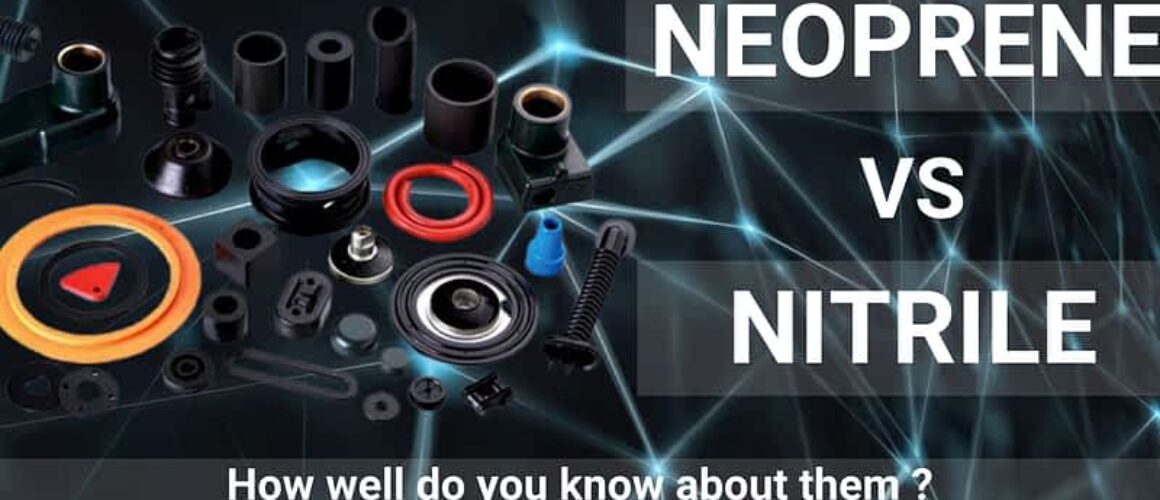Do You Know The Difference Between Neoprene & Nitrile (NBR) Rubber ???
Many Rubber product manufacturersrely on various types of synthetic rubber due to various reasons. The demand for synthetic rubbers over natural rubber has increased very rapidly over the recent past. There are many types of synthetic rubber and they are broadly classified into two categories, namely; general-purpose synthetic rubbers and special purpose rubber. General-purpose rubbers are more common and widely used in many manufacturing processes. Neoprene and nitrile rubber are two such widely used general-purpose rubbers. The key difference between neoprene and nitrile rubber is that neoprene is produced by emulsion polymerization of chloroprene (2-chloro-1, 3-butadiene), whereas nitrile rubber is produced by emulsion polymerization of copolymers of butadiene and acrylonitrile.
Nitrile and neoprene exhibit similar properties, but with differing characteristics that make them useful for different applications. Both materials are elastic, and will return to their original shape when stretched. Nitrile is particularly resistant to chemicals, abrasion, and temperatures, while neoprene is valued for its weather resistance and durability.
What’s the difference between nitrile vs. neoprene for seals, gaskets, and insulation? Both elastomers provide good resistance to compression set and tearing. They withstand the same range of service temperatures, too. Some grades of neoprene offer excellent resistance to abrasion, but nitrile is known for its abrasion resistance at elevated temperatures.
Nitrile and neoprene rubber have many similarities, but there are some important differences between these elastomers. Below we provide a more in-depth look at the properties and advantages of nitrile and neoprene and their industrial uses.
PROPERTIES | NITRILE | NEOPRENE |
| ELONGATION | 400% to 600% | 100% to 800% |
| HARDNESS | 35 to 90 | 15 to 95 |
| COMPRESSION SET | Good | Good |
| ABRASION RESISTANCE | Good to Excellent | Very Good to Excellent |
| CRACKING RESISTANCE | Good | Good to Very Good |
| TEAR RESISTANCE | Good | Good |
| FLAME RESISTANCE | Poor | Very Good to Excellent |
| MINIMUM TEMP. | -34° C to -56° C | -34° C to -56° C |
| MAXIMUM TEMP. | +104° C to +137°C | +104° C to +137° C |
| WEATHER RESISTANCE | Poor | Good |
| SUNLIGHT RESISTANCE | Poor | Good to Very Good |
| OZONE RESISTANCE | Poor | Good |
| OXIDATION RESISTANCE | Good | Good |
| WATER RESISTANCE | Good to Excellent | Excellent |
| STEAM RESISTANCE | Fair | Poor to Good |
| GAS PERMEABILITY | Fair to Good | Fair to Good |
| CHEMICAL RESISTANCE | Generally resistant to Gases, Aliphatic Hydrocarbon, Oils and Fuels | Generally resistant to Moderate chemicals and acids, ozone, oils, fats, greases, and solvents |
| NO CHEMICAL RESISTANCE | Generally attacked by Ketones, Ozone, Sunlight, Aromatic Oil, Flame, Weather | Generally attacked by Esters, ketones, and chlorinated, aromatic, and nitro hydrocarbons |
Also read: A Guide To Know The Difference Between Silicone Rubber & EPDM !!
Nitrile Vs Neoprene Applications
Nitrile rubber is recommended for applications that require oil and fuel resistance, abrasion resistance, and temperature resistance up to 280° F. In mobile equipment and military vehicles, nitrile seals or gasketsare used in carburetor diaphragms, fuel systems, and hydraulic hoses as well as a popular option for highly durable and disposable medical gloves. Nitrile also supports rubber-to-metal bonding, which makes it a good choice for applications in the processing industry. Yet nitrile isn’t recommended for sealing and insulation that requires resistance to fire, sunlight, ozone, or weather.
Neoprene rubber resists fire and withstands sunlight, ozone, and weather. Specific grades of neoprene can also meet flame, smoke and toxicity (FST) requirements for the mass transit industry. Applications include door seals, window seals, hose covers, vibration mounts, and shock absorbers. Neoprene is also used with HVAC units, electrical or electronic enclosures, and weather stripping for fire doors. Neoprene noise isolators are used to reduce sound vibrations from power transformers. Additional applications include expansion joints and bearing pads in built structures.
Compound selection is critical because choosing the wrong rubber can cause more than just a component-level failure. Depending on your application’s specific needs and requirements, both nitrile and neoprene offer a variety of benefits.


